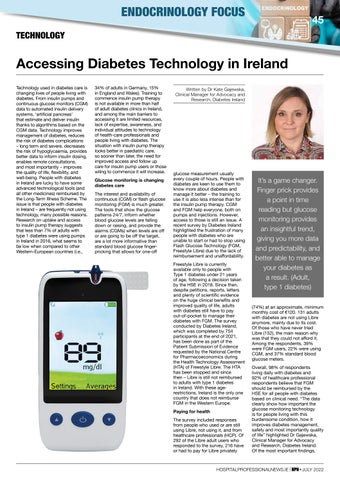ENDOCRINOLOGY FOCUS
45
TECHNOLOGY
Accessing Diabetes Technology in Ireland Technology used in diabetes care is changing lives of people living with diabetes. From insulin pumps and continuous glucose monitors (CGM) data to automated insulin delivery systems, ‘artificial pancreas’ that estimate and deliver insulin thanks to algorithms based on the CGM data. Technology improves management of diabetes, reduces the risk of diabetes complications – long term and severe, decreases the risk of hypoglycaemia, provides better data to inform insulin dosing, enables remote consultations, and most importantly – improves the quality of life, flexibility, and well-being. People with diabetes in Ireland are lucky to have some advanced technological tools (and all other medicines) reimbursed by the Long-Term Illness Scheme. The issue is that people with diabetes in Ireland – are frequently not using technology, many possible reasons. Research on uptake and access to insulin pump therapy suggests that less than 7% of adults with type 1 diabetes were using pumps in Ireland in 2016, what seems to be low when compared to other Western-European countries (i.e.,
34% of adults in Germany, 15% in England and Wales). Training to commence insulin pump therapy is not available in more than half of adult diabetes clinics in Ireland, and among the main barriers to accessing it are limited resources, lack of expertise, awareness, and individual attitudes to technology of health-care professionals and people living with diabetes. The situation with insulin pump therapy looks better in paediatric care, so sooner than later, the need for improved access and follow up care for insulin pump users or those wiling to commence it will increase. Glucose monitoring is changing diabetes care The interest and availability of continuous (CGM) or flash glucose monitoring (FGM) is much greater. The tools that show the glucose patterns 24/7, inform whether blood glucose levels are falling down or raising, and provide the alarms (CGMs) when levels are off or are going to be off the target, are a lot more informative than standard blood glucose fingerpricking that allows for one-off
Written by Dr Kate Gajewska, Clinical Manager for Advocacy and Research, Diabetes Ireland
glucose measurement usually every couple of hours. People with diabetes are keen to use them to know more about diabetes and manage it better – the training to use it is also less intense than for the insulin pump therapy. CGM and FGM help everyone, both on pumps and injections. However, access to those is still an issue. A recent survey by Diabetes Ireland highlighted the frustration of many people with diabetes who are unable to start or had to stop using Flash Glucose Technology (FGM, Freestyle Libre) due to the lack of reimbursement and unaffordability. Freestyle Libre is currently available only to people with Type 1 diabetes under 21 years of age, following a decision taken by the HSE in 2018. Since then, despite petitions, reports, letters and plenty of scientific evidence on the huge clinical benefits and improved quality of life, adults with diabetes still have to pay out-of-pocket to manage their diabetes with FGM. The survey conducted by Diabetes Ireland, which was completed by 754 participants at the end of 2021, has been done as part of the Patient Submission of Evidence requested by the National Centre for Pharmacoeconomics during the Health Technology Assessment (HTA) of Freestyle Libre. The HTA has been stopped and since then – Libre is still not reimbursed to adults with type 1 diabetes in Ireland. With these agerestrictions, Ireland is the only one country that does not reimburse FGM in the Western Europe. Paying for health The survey included responses from people who used or are still using Libre, not using it, and from healthcare professionals (HCP). Of 292 of the Libre adult users who responded to the survey, 216 have or had to pay for Libre privately
It’s a game changer. Finger prick provides a point in time reading but glucose monitoring provides an insightful trend, giving you more data and predictability, and better able to manage your diabetes as a result. (Adult, type 1 diabetes) (74%) at an approximate, minimum monthly cost of ¤120. 131 adults with diabetes are not using Libre anymore, mainly due to its cost. Of those who have never tried Libre (152), the main reason why was that they could not afford it. Among the respondents, 39% were FGM users, 22% were using CGM, and 37% standard blood glucose meters. Overall, 98% of respondents living daily with diabetes and 92% of healthcare professional respondents believe that FGM should be reimbursed by the HSE for all people with diabetes based on clinical need. “The data clearly show how important the glucose monitoring technology is for people living with this burdensome condition, how it improves diabetes management, safety and most importantly quality of life” highlighted Dr Gajewska, Clinical Manager for Advocacy and Research, Diabetes Ireland. Of the most important findings,
HOSPITALPROFESSIONALNEWS.IE | HPN • JULY 2022























